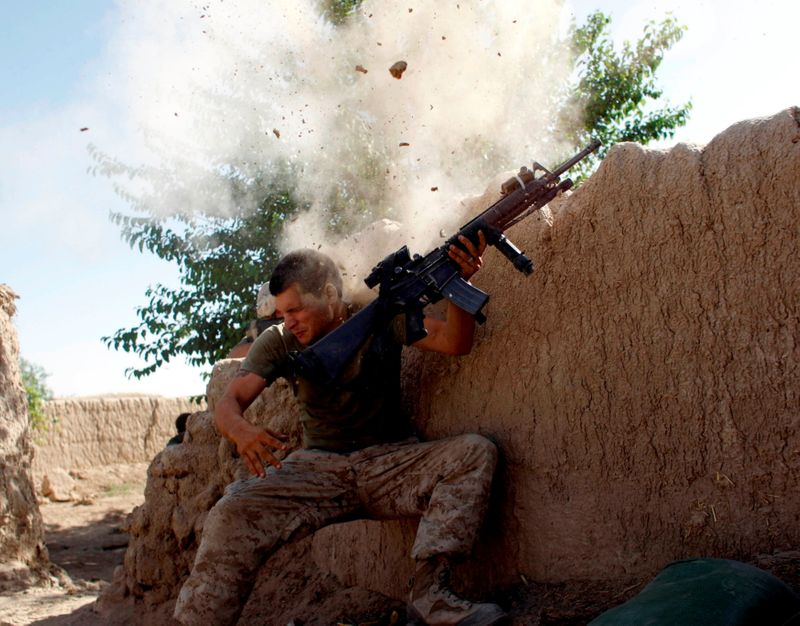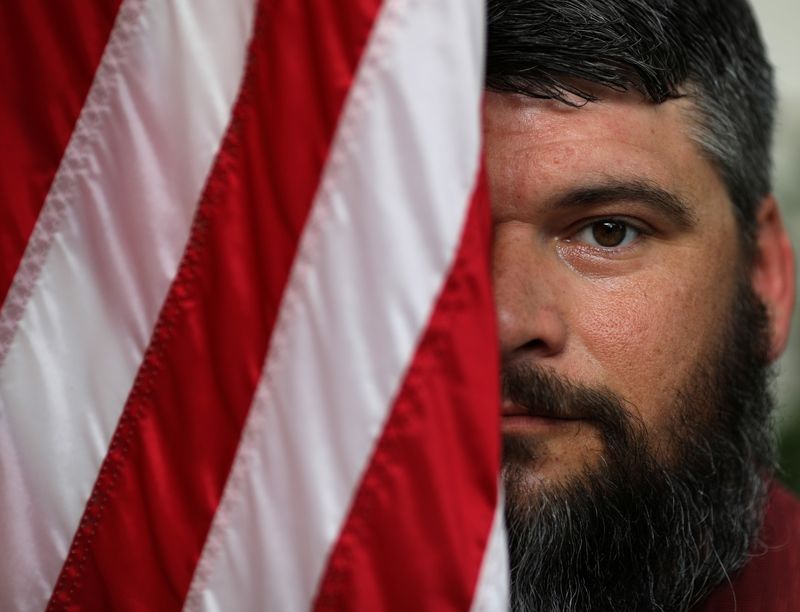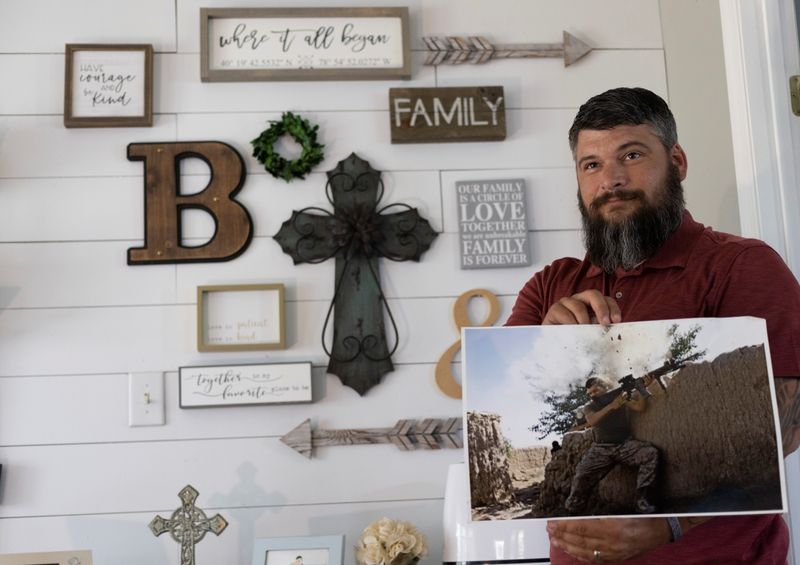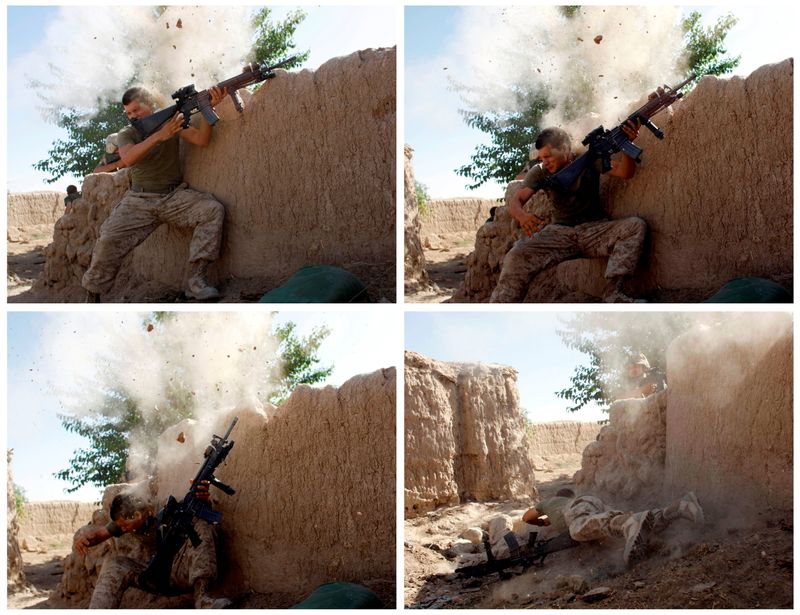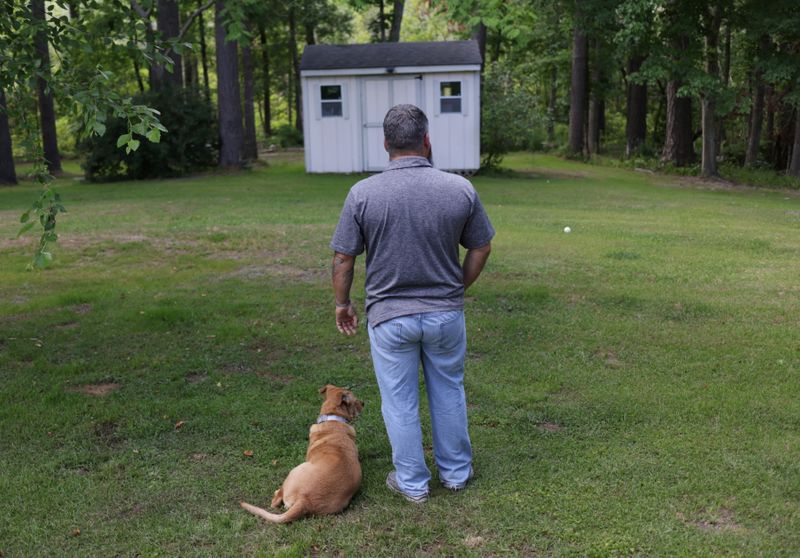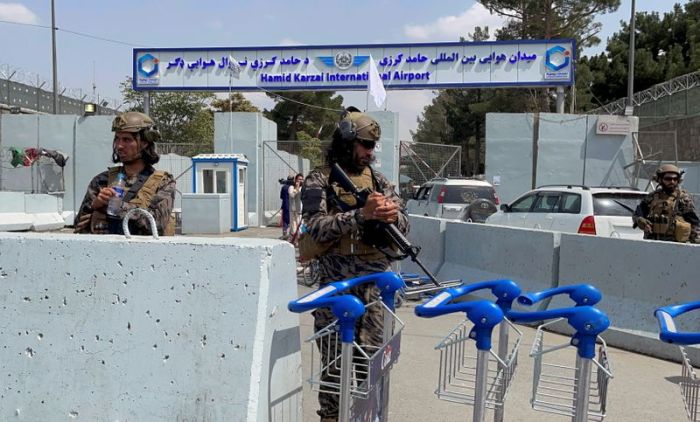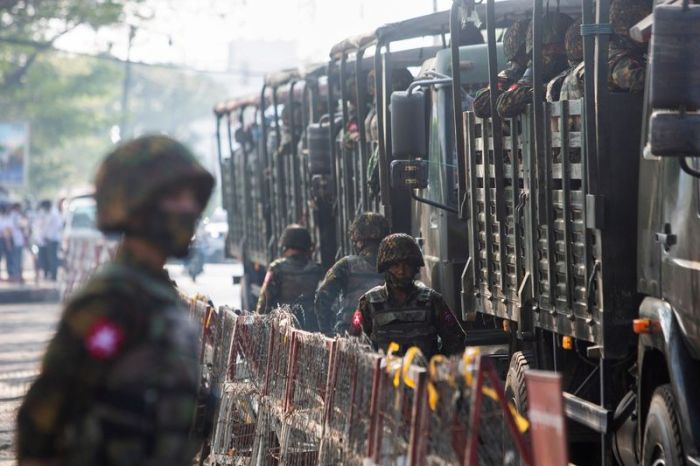JACKSONVILLE, N.C. (Reuters) – Today, on a leafy cul-de-sac in North Carolina, his hair is streaked with gray, and he wears his beard long. But on that day 13 years ago, as he sat tucked behind a mud wall in Afghanistan, his head was close-cropped, bare and vulnerable.
Retired U.S. Marine Sgt. Billy Bee is sharing a smoke with Reuters photographer Goran Tomasevic on the deck of Bee’s home. The smoke hangs in the humid, still air, just as it did on May 18, 2008, when their lives were stitched together in a single moment of explosive violence and unlikely survival.
They are two men united by war, coming together again as the messy and tragic American involvement in Afghanistan finally was coming to an end, 20 years after the Sept. 11 attacks on New York and Washington, D.C., set it all in motion.
Both men remember that 2008 day as being blisteringly hot and humid. Tomasevic was in his underwear and boots, fiddling with a new lens, snapping shots of Bee near Garmsir, in Helmand province, as they talked and smoked. When shots came from a nearby hut, just beyond the wall, Tomasevic rushed into a nearby building inside the compound and grabbed some clothes, his protective vest and a helmet.
He lay down next to Bee. The sergeant was a slim 26-year-old at the time, carrying an M-16 rifle that seemed almost as large as him from some angles. He wasn’t wearing any body armor or a helmet but poked his head above the wall, anyway, looking for targets. Tomasevic, then 38, kept taking pictures.
Moments later, a shot hit the top of the wall near Bee’s head, exploding the mud and knocking him down and backward.
“And for the first time in my career, I drop the camera,” Tomasevic says in his clipped English, spoken with a Serbian accent. “I look at him lying down. I said, ‘Bee, Bee,’ and I look: Where is the blood? The bleeding? And I look around and there is nothing, man, no bleeding.”
Bee was briefly unconscious but apparently fine. Later, going through the images he took, Tomasevic showed Bee the picture he caught the moment the round hit the wall. “You are going to be famous,” he told the Marine.
And within hours, the picture had appeared on websites and newspapers around the world. For more than a decade, a framed print of the picture hung on the walls of the Reuters newsroom in New York City, an exemplar of the news agency’s photojournalism. That shot, taken by a photographer whose own life was forged by war in his native land, is one of the iconic pictures of the conflict in Afghanistan, capturing the eternal fragility of service members at war.
Bee loves the picture. It makes him laugh.
“I look at it with fondness. I mean, yeah, the situation was shitty at the time, the environment sucked, the whole experience was godawful. Except for, you know, the firefights and stuff like that. That’s, honestly, where I think I was having the most fun of my career,” Bee says. “As long as we’re not losing guys, I’m having a blast doing that stuff.”
As it turned out, Bee wasn’t fine after that picture was taken. The concussive effect of the bullet hitting so close to his head knocked him out. The image may have documented the first traumatic injury to the front of his brain, where short-term memory and reasoning are processed. There would be at least one more head injury in June 2010 that resulted in the discovery of brain damage, his medical records show. Nearly a decade after his first deployment as one of the first Marines in Afghanistan, he would never be cleared for combat again.
Bee, who left the Marines in April 2013, has a frontal lobe brain injury that affects his short-term memory. He has been diagnosed with post-traumatic stress disorder, depression and rage disorder.
But that picture thrust him into the public eye, and he and his wife, Bobbie Bee, have used it to advance the cause of care of service members damaged by war. Today, Bee is routinely quoted in news stories published worldwide and is often cited as an example of how the Veterans Administration struggled to adequately care for service members suffering from mental health problems brought on by their service.
Back in 2008, on the home front, Bobbie was pregnant with their son Ethan. It was Bee’s third deployment in Afghanistan but the first time he had shipped out overseas since they were married in 2006. Until that picture was published, her husband’s absence half a planet away in a war-ravaged land didn’t seem very different from when he went away for training.
Bee never called his wife to let her know about the picture, even though Tomasevic offered to let him use his satellite phone. Shortly after the picture was published, she stumbled onto it while visiting a news site for military families.
“I let out a scream that my parents still remember, because they thought I was going into labor,” she says. “When I saw that picture, I am, like, this is real.”
It was 78 hours before he called and she was sure her husband was alive.
“When we first talked, it was like, oh my gosh, I’m so excited you’re OK. And then I was like, WHERE WAS YOUR GEAR? And he’s like, what happened to the sweet wife who is so thankful I’m OK?”
In the years that followed, Bee suffered from depression and flashbacks. Two or three times a week, he woke up feeling adrenaline rushing through his body as if readying himself for a bar fight. During the day, a mild irritant for most people could turn to fury in him. He self-medicated with alcohol, he says.
In October 2010, Bobbie Bee says, she came home to find him passed out in the kitchen. Earlier they had fought, and he left her a note, saying goodbye. He wanted to die.
“I tried: two liters of tequila in about two minutes,” he recalls. “Her and I had got into a huge fight and I say: ‘I’m done. Fuck this. I have had enough.'”
Bobbie Bee says she had struggled with his angry outbursts for months since his return, but now she was scared for his life. She wanted to take him to the hospital but worried about what it would do to his career. He was too heavy for her to move far, so she propped him up against the fridge and taped his head to the door so he couldn’t choke on his vomit.
“I used really strong packing tape,” she says, chuckling with her husband as they recall the episode. “But at the time, it was horrifying. I didn’t know what to do. I didn’t have family. They were 500 miles away.”
Fortunately, a corpsman friend lived nearby, and he brought over saline IV drips. He inserted them into his fellow Marine’s arms, and eventually, Bee regained consciousness. “And then I wake up with my head duct-taped to the fridge and two mainline IVs in my arm,” he recalls.
With the help of his wife, Bee eventually got treatment and now takes seven prescriptions every day, including several antipsychotic and anti-depression drugs. He has a job working for a company that designs autonomous targeting robots that the Marines use for combat training. He works nights, on Camp Lejeune, the famed Marine base near his home.
Sitting on the back porch, Bobbie Bee watches her husband chat with Tomasevic, who’s visiting the U.S. from his home in Turkey, and says she saw, in that moment, a bit of the man she met and married rather than the man who came home from war. The two men came together to reflect on the years of warfare in response to the 2001 attacks.
“Billy can tell you everything from June 8th, 2010, and prior, as if it just happened, but if you ask him what he had for dinner yesterday, he wouldn’t remember,” she says.
“The time he spent with Goran and things like that, he remembers. So that’s what makes him happy.”
And while sitting next to Tomasevic, he laughs and reminisces about the weeks they spent together, sleeping on cardboard, and numerous firefights with the Taliban. Bee’s memory of those days is precise and detailed.
“I cannot believe I have come to his house,” Tomasevic says. “I feel really good, but I still can’t believe I’m here talking to him. We can’t stop talking.”
Tomasevic spent about three weeks with Bee’s unit in 2008. They came together again in 2010 in Marjah, Afghanistan, shortly before the last injury that ended the Marine’s combat career.
Tomasevic has continued working in conflict zones for Reuters, from the Arab Spring in Egypt to the fighting in Syria, Libya and, of course, Afghanistan. He insists he is more than the work he has done shooting conflict and despair.
“I am a professional. I shoot sports, whatever.”
But he acknowledges that he takes special pride in his war work. “I have an affection for war and conflict because I believe this is the hardest to do in this job.”
Thirty years after joining Reuters during the civil war in his native country, then Yugoslavia, he says he can compartmentalize the images, so they don’t damage him in the way others might be damaged.
“I grew up in a war zone. And I have been doing this for 30 years.”
(Reporting by Maurice Tamman; editing by Kari Howard)

